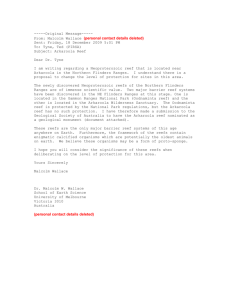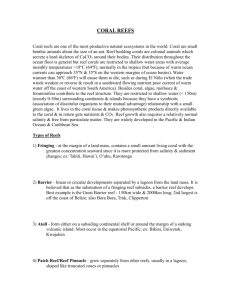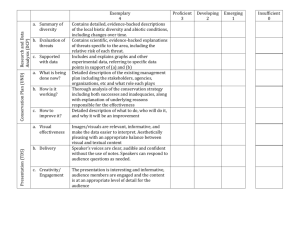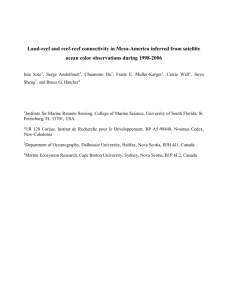Reefs - 10th grade AP Earth Science
advertisement
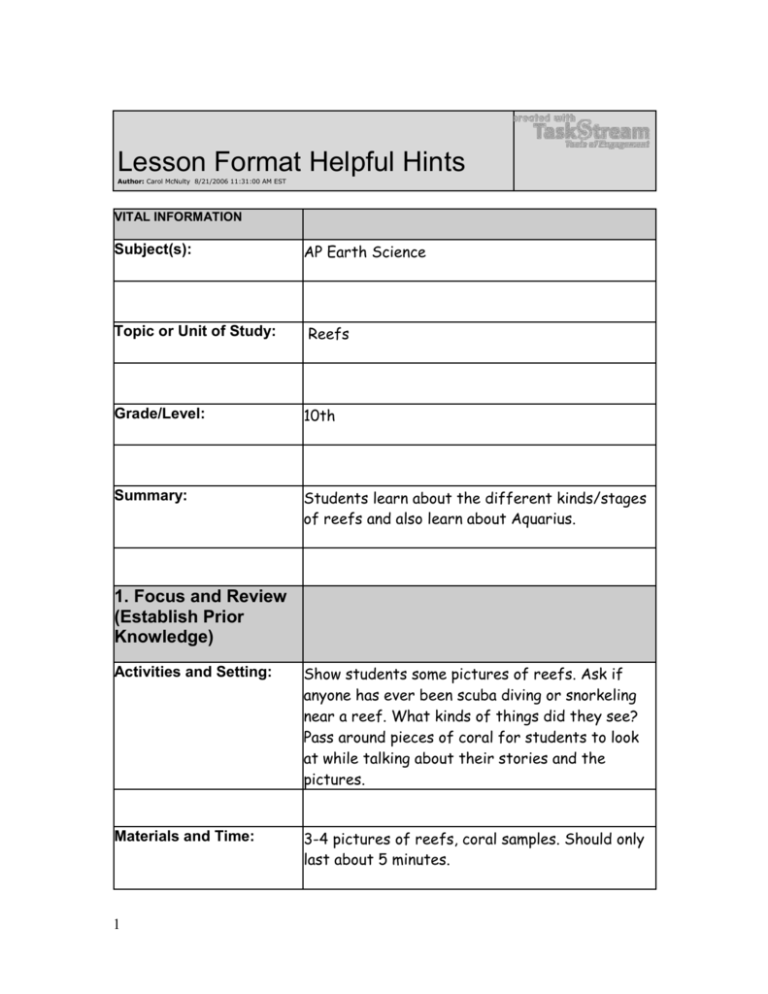
Lesson Format Helpful Hints Author: Carol McNulty 8/21/2006 11:31:00 AM EST VITAL INFORMATION Subject(s): AP Earth Science Topic or Unit of Study: Reefs Grade/Level: 10th Summary: Students learn about the different kinds/stages of reefs and also learn about Aquarius. 1. Focus and Review (Establish Prior Knowledge) Activities and Setting: Show students some pictures of reefs. Ask if anyone has ever been scuba diving or snorkeling near a reef. What kinds of things did they see? Pass around pieces of coral for students to look at while talking about their stories and the pictures. Materials and Time: 3-4 pictures of reefs, coral samples. Should only last about 5 minutes. 1 II. Statement (Inform) of Objectives Activities and Setting: By doing your own research and presenting your artistic models to the class you will learn in-depth information about the reef ecosystems. I will help teach you how to go about researching your own topics. Hopefully after this lesson, the next time you go snorkeling or scuba diving you’ll know more about what kind of reef you’re swimming in. Materials and Time: Should be a very quick explanation. III. Teacher Input (Present tasks, information, and guidance) Activities and Setting: I will have the students break up into five groups. Preferably the groups have about 4-5 students but I’m sure my class sizes will vary. Each group will get a sheet telling them what type of reef they are to research (abiotic reefs, oyster reefs, fringing reefs, atolls, or barrier reefs) and detailing what will be expected of them in the diorama and presentation. After answering any of their questions I will let them move to the computers to do their research and begin making their models. Materials and Time: 10 minutes IV. Guided Practice (Elicit performance) 2 Activities and Setting: While the students are researching their reefs and making their models I will be walking around the room making sure that each group is on task and headed in the right direction. If there are particular details that I want each group to present with their section I will make sure that they find and understand those points. If any group is having a particularly hard time locating information I could help by supplying websites or helping them refine their search. Materials and Time: Varies. V. Independent Practice- Seatwork and Homework (Retain and transfer) Activities and Setting: After the intro activity, the students will break off into groups to do their independent research on the type of reef assigned to them. There will be five groups (abiotic reefs, oyster reefs, fringing reefs, atolls, and barrier reefs). Each group will have the first class to research their reef type, and begin making a model of it. The models should creatively and accurately reflect the fish and plants that would be found in each reef. The models will be shoebox diaramas made of supplies that I have asked them to bring in over the course of the week (shoeboxes, glue, toys to use as props) as well as classroom supplies (construction paper, glue, scissors, markers, crayons, popsicle sticks). that I already have. The second day will be devoted to the presentations. They will have fifteen minutes to finish up their diaramas before beginning their presentations. Each presentation should last 5-10 3 minutes. Each member of the group should contribute something to the presentation. During the presentation each group should discuss the defining characteristics of their reef, the kinds of plants and animals that would be found there, as well as explain and describe their diarama. After the coral reef section’s presentations (fringing reef, barrier reef, atolls) we will spend the rest of the class looking at the aquarius webcams and having a short skype chat with the aquanauts. The students will be able to ask the aquanauts questions about what kind of reef Aquarius is located in and see how accurate their diarams and presentations were. Materials and Time: Each student will complete a worksheet during the presentations showing that they were paying attention and to serve as notes for that section. The majority of two 1.5 hour class periods VI. Closure (Plan for maintenance) Activities and Setting: I will review the worksheet with them and make sure that any of their questions are answered. If possible I will have the presenting group answer questions but I understand that there may be topics that all of the students struggle with. Materials and Time: About 5 minutes or less. STANDARDS & ASSESSMENT Standards: 4 Objective 2.05 Investigate the biosphere: ecosystems and change. Assessment/Rubrics: Presentation/Diorama rubric: creativity- 15 participation of each student- 30 clear explanations of: fish in reef- 5 locations- 5 plants in reef- 5 importance of reef ecosystem to humans- 15 accuracy of diorama - 25 Final worksheet: 1. List two plants that would be found in this reef 2. List three animals that would live in this ecosystem 3. Why is this ecosystem important to humans? Does it have any natural resources that we rely on? 4. Where in the world would this reef be found? Are there any famous examples? Reflective Information (complete after lesson is implemented) 5 Author's Comments & Reflections: 6 You would complete this section after teaching.
